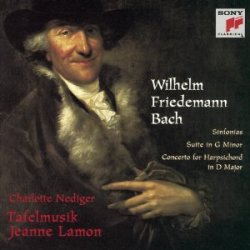Wilhelm Friedemann Bach – Sinfonias
Wilhelm Friedemann Bach – Sinfonias

Sinfonia in D major (used as prelude to cantata 'Dies ist der Tag'), F. 64
1. Sinfonia in D major F. 64 (BR C8): 1. Allegro e maestoso
2. Sinfonia in D major F. 64 (BR C8): 2. Andante
3. Sinfonia in D major F. 64 (BR C8): 3. Vivace
4. Sinfonia in D minor ('Adagio and Fugue'), F. 65 (BR C7)
Overture (Suite) for strings & continuo in G minor 'No. 5' (doubtful), BWV 1070
5. 1. Ouverture. Larghetto
6. 2. Torneo play
7. 3. Aria. Adagio
8. 4. Menuetto alternativo - Trio
9. 5. Capriccio
Harpsichord Concerto in D major, F. 41
10. 1. Allegro Listen
11. 2. Andante Listen
12. 3. Vivace Listen
Sinfonia for strings in F major ('Dissonant'), F. 67
13. 1. Vivace Listen
14. 2. Andante Listen
15. 3. Allegro Listen
16. 4. Menuetto 1 & 2 play
Charlotte Nediger – harpsichord
Tafelmusik (on period instruments)
Jeanne Lamon – director
W.F. was Bach's oldest son, and musical history hasn't been kind to him for a number of reasons. Apparently he had a drinking problem or some other behavioral difficulty, since he seemed to have trouble keeping a job. When his father died, he received a third of his music manuscripts and proceeded to sell or pawn them, which is why so many of Bach's cantatas and other works are lost. As a composer his music obviously shows something of his father's influence, and possibly that of alcohol--and many great musicians have been alcoholics. Well, his music is certainly interesting, and these are fine performances. Give them a whirl. ---David Hurwitz, Editorial Reviews
This disc goes a long way to support the idea that Wilhelm Friedemann, despite his personal problems, was the most talented composer of Bach's sons. Indeed, the Suite in G minor included here was long considered to be the work of Sebastian. All of the music performed here has a vitality and craftsmanship that is very appealing. The opening Sinfonia in D has a sound very reminiscent of the Dresden school, and is optimistic and slightly quirky. The highlight for me is the Sinfonia in D minor for two flutes, strings and continuo. It starts with a very slow langorous adagio which employs striking dissonances between the flutes and moves into a fugue of tremendous contrapuntal rigor. Here is where the musical genuis of Wilhelm is most evident as this fugue shows him to be a very good pupil of his father, except that it is made all the more interesting by some shocking harmonic side-steps. The music of Wilhelm Friedemann has never been very well recorded, and this appears to be one of the best programs available. Tafelmusik play flawlessly with great passion and verve. --- scott (Calgary, Canada)
download: uploaded anonfiles mega 4shared mixturecloud yandex mediafire ziddu
Last Updated (Saturday, 17 August 2013 20:34)








